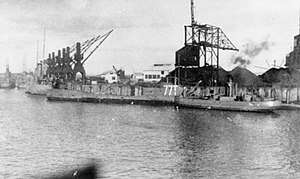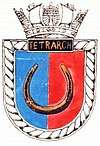HMS Tetrarch (N77)
HMS Tetrarch (N77) was a T-class submarine of the Royal Navy. She was laid down by Vickers Armstrong, Barrow and launched in November 1939.
 HMS Tetrarch | |
| History | |
|---|---|
| Name: | HMS Tetrarch |
| Builder: | Vickers Armstrong, Barrow |
| Laid down: | 24 August 1938 |
| Launched: | 14 November 1939 |
| Commissioned: | 15 February 1940 |
| Fate: | sunk 2 November 1941 |
| Badge: |
 |
| General characteristics | |
| Class and type: | British T class submarine |
| Displacement: |
|
| Length: | 275 ft (84 m) |
| Beam: | 26 ft 6 in (8.08 m) |
| Draught: | 16.3 ft (5.0 m) |
| Propulsion: |
|
| Speed: |
|
| Range: | 4,500 nautical miles at 11 knots (8,330 km at 20 km/h) surfaced |
| Test depth: | 300 ft (91 m) max |
| Complement: | 59 |
| Armament: |
|
Career
In common with many of her class, Tetrarch saw extensive service in the key naval theatres, Home waters, serving in the North Sea and off the French and Scandinavian coasts, and the Mediterranean.
Home waters
Tetrarch's first success came in May 1940 when she torpedoed and sank the German submarine chaser UJ B / Treff V in the Skagerrak. She also sank the Danish fishing vessel Terieven and the German tanker Samland, and captured the Danish fishing vessel Emmanuel, which was taken to Leith as a prize.
Mediterranean
Tetrarch was assigned to operate in the Mediterranean in late 1940. She sank the Italian merchants Snia Amba, Giovinezza and Citta di Bastia, the Italian tanker Persiano, the Italian sailing vessels V 72/Fratelli Garre, V 113/Francesco Garre and Nicita, and the Greek sailing vessel Panagiotis Kramottos. She also damaged the German merchant Yalova and claimed to have damaged a sailing vessel in the Aegean. Tetrarch also carried out an unsuccessful attack on the Greek tanker Olympos.[1]
Sinking
Tetrach sailed from Malta on 26 October 1941 for a refit in Britain, via Gibraltar. She failed to arrive in Gibraltar on 2 November and was declared overdue. Her route passed through a known minefield. On Monday 27 she communicated with P34, which was in the same area. This was the last contact with the submarine. She is presumed lost to Italian mines off Capo Granditola, Sicily, Italy in late October 1941.[2]
Notes
- HMS Tetrarch, Uboat.net
- Submarine losses 1904 to present day, RN Submarine Museum, Gosport
References
- Akermann, Paul (2002). Encyclopaedia of British Submarines 1901–1955 (reprint of the 1989 ed.). Penzance, Cornwall: Periscope Publishing. ISBN 1-904381-05-7.
- Bagnasco, Erminio (1977). Submarines of World War Two. Annapolis, Maryland: Naval Institute Press. ISBN 0-87021-962-6.
- Caruana, Joseph (2012). "Emergency Victualling of Malta During WWII". Warship International. LXIX (4): 357–364. ISSN 0043-0374.
- Colledge, J. J.; Warlow, Ben (2006) [1969]. Ships of the Royal Navy: The Complete Record of all Fighting Ships of the Royal Navy (Rev. ed.). London: Chatham Publishing. ISBN 978-1-86176-281-8.
- Chesneau, Roger, ed. (1980). Conway's All the World's Fighting Ships 1922–1946. Greenwich, UK: Conway Maritime Press. ISBN 0-85177-146-7.
- Kemp, Paul J. (1990). The T-class Submarine: The Classic British Design. Annapolis, Maryland: Naval Institute Press. ISBN 1-55750-826-7.
- McCartney, Innes (2006). British Submarines 1939–1945. New Vanguard. 129. Oxford, UK: Osprey. ISBN 1-84603-007-2.